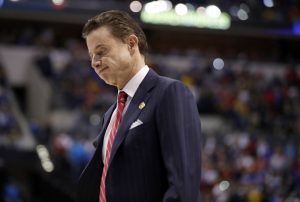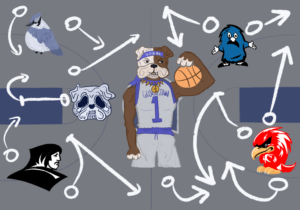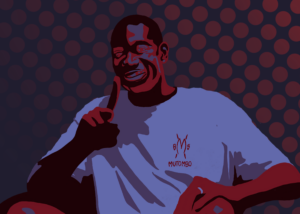Since 2011, the Champion’s Classic has served as the unofficial commencement of the men’s college basketball regular season. Four premier Division I programs (Duke, Kentucky, Kansas, and Michigan St.) are featured in an early-season display of what purports to be the best that the sport has to offer.
However, an important caveat to these games is that none of the teams are anywhere near their peak performance with regards to comfort or cohesiveness. With many of college basketball’s talents staying just one year in college, the Champions Classic is often the first time, say, a Duke starting point guard will play in a nationally televised game of importance, and the early-season jitters are obvious. Furthermore, the 20-odd practices and two games that each of these teams have had cannot simulate the reality of going up against College Basketball’s elite. The ball has a tendency to get stuck on offense, and defensive concepts are still fuzzy.
With all that being said, we can still make some extrapolations and predictions based off what each team showed in the Champions Classic. Here are four takeaways from the event:
- Grayson Allen is B-A-C-K.
For all of the 2016-17 season, Grayson Allen was under the college basketball microscope. The junior guard known for his brash, relentless style of attacking the basket had garnered attention for all the wrong reasons. In his sophomore year, Allen was caught on tape tripping opposing players several times, to go along with his penchant for embellishing physical contact. Allen kept up the act in his junior year, tripping an Elon player in a December showdown before having a temper tantrum right in the middle of the game. Allen, who was widely chosen as the preseason pick for National Player of the Year, saw his performance flounder due to a combination of behavioral issues and complications related to a foot injury. College basketball’s favorite heel was suffering, and opposing fans delighted in his (and Duke’s) failure to live up to preseason expectations.
But this year, it appears that Grayson Allen is back, back again, and you can tell a friend. The now-senior guard has taken a leadership role on Duke’s young roster of star-studded prospects and is shouldering the offensive load while his teammates adjust to the speed of the college game. In Tuesday’s game, prized Blue Devil freshman Marvin Bagley III left late in the first half with an eye injury. Allen took over, nailing a three to end the period and pouring in 23 in the second half to lead the top-ranked Blue Devils to victory over no. 2 Michigan State. The Ted Cruz look-alike showed his full offensive arsenal, sporting a deadly mid-range pull-up jumpshot to go along with his long-distance prowess. The Blue Devils don’t need Allen to score 37 points every night to win the national championship, but the guard’s performance against the Spartans shows that he is comfortable in both a scoring and a facilitating role. That spells trouble for the rest of the country.
- The Michigan State Spartans have never seen a zone defense
As a good American fulfilling my duty to root against Duke, I found Michigan State’s strategy of passing the ball right to the Blue Devils quite puzzling. Duke’s struggles on the defensive end in the past few years have been well-documented, and Mike Krzyzewski has often shifted into a zone defense, either 2-3 or 1-3-1, to hide some of his players’ aversion to guarding anyone. While the Blue Devils looked more active in the zone tonight than in years past, the reality is that Duke’s zone is an imperfect substitute for Coach K’s preferred man-to-man defense.
The Spartans played as if attacking a zone defense was an entirely foreign concept, repeatedly dribbling into trouble and making errant passes right to the Duke players. For all his talent, Miles Bridges looked flustered by Duke’s defensive scheme, shot-faking and then driving straight into the teeth of the zone, before coughing it up or pitching the ball out in vain. Three Spartans committed four or more turnovers, a disheartening number for a team that returns several key contributors from last year. Michigan State will undoubtedly tighten up their ball security, as any further continuity of their current turnover rate would drive head coach Tom Izzo insane. You know what else probably drives Tom Izzo insane? The fact that he is now 1-11 against Coach K, and a combined 1-18 against Blue Bloods from the state of North Carolina.
- Kentucky is young but not star-studded
We all know John Calipari’s modus operandi by now: recruit as many blue-chip prospects as possible to play in Lexington, and manage their personalities and talents to create a cohesive, winning product on the floor. So far, Coach Cal’s strategy has worked for Big Blue Nation. Calipari has taken the Wildcats to four Final Fours and won a National Championship since arriving at Kentucky in 2009, quickly re-establishing the program as arguably the best in College Basketball.
Calipari’s teams, however, are not all created equally. Recruiting rankings are just a number, as the individual talents and skills of the players, and how they fit in with each other, ultimately determines the team’s success. In 2016-17, the Wildcats had all the necessary parts: a lightning-quick, dynamic point guard in De’Aaron Fox, and a supremely gifted shooter and scorer in Malik Monk. This year, the ‘Cats have neither a proven floor general like Fox nor an offensive threat with Monk’s arsenal. Instead, Kentucky has a bizarre assortment of tall and athletic wing scorers who sometimes appear as if they can play all five positions, but other times look lost on the court. Calipari has embraced positionless basketball as this team’s outlook, but it is an experiment that may backfire. Freshman Shai Gligeous-Alexander struggled early and often against the Jayhawks, committing six turnovers and leading a puzzled Kentucky offense. The Wildcats are talented, but their team will likely go as far as freshman Kevin Knox, a 6’9” stretch-four who poured in 20 against Kansas, will take them. The good news for Big Blue Nation is that despite their issues, Kentucky stayed close with the older, more experienced Jayhawks and only lost by four, 65-61.
- Kansas’ four-guard experiment is exciting
Kansas head coach Bill Self is arguably the best coach in the game when it comes to adjusting his team’s style to its personnel. This year, Self realizes that he is once more short-handed on the interior and has opted to utilize a guard-heavy rotation. Even after freshman forward Billy Preston makes his KU debut, the Jayhawks will still ride and die by the performance of their guards, including senior Devonte’ Graham and sophomores Malik Newman and LaGerald Vick.
Graham has been placed on a number of preseason award lists and figures to be Kansas’ crunchtime option, but the Jayhawks will need all of their guards to punch above their weight, literally speaking. This is not to say that Preston, along with freshman Marcus Garrett and sophomore Udoka Azubuike, will not turn into a formidable front line. In fact, I would go as far as to wager that Kansas’ frontcourt potential is perhaps second only to that of Duke. However, should the Jayhawks run into any continued problems on the interior, Self is going to rely on the likes of Graham to not only shoulder an outsized scoring load, but also to pick up some rebounds and defensive positioning that he may not normally look for.
Photo: Duke Athletics





